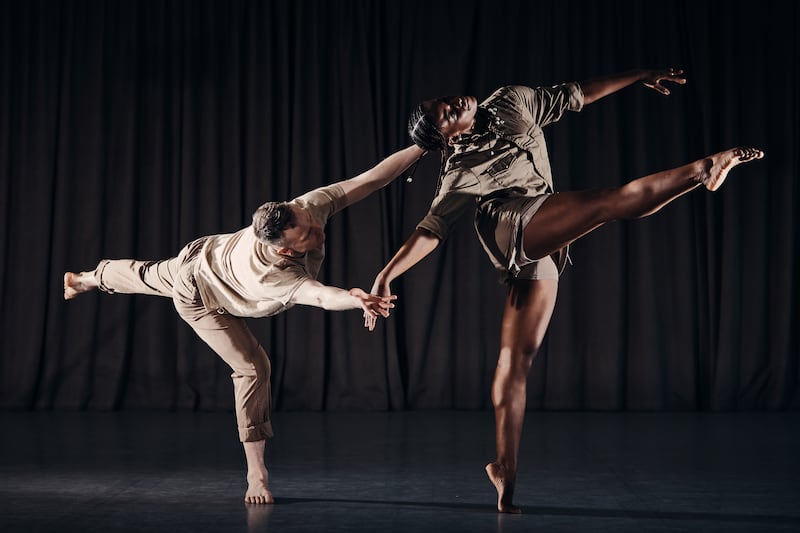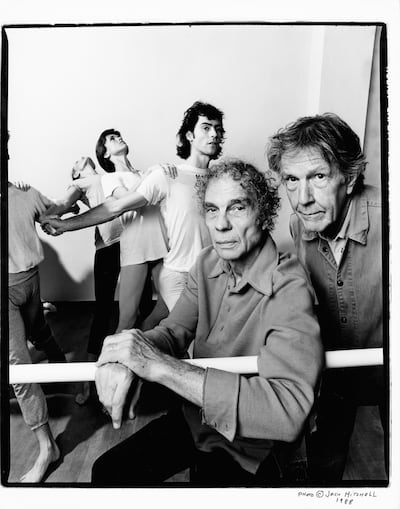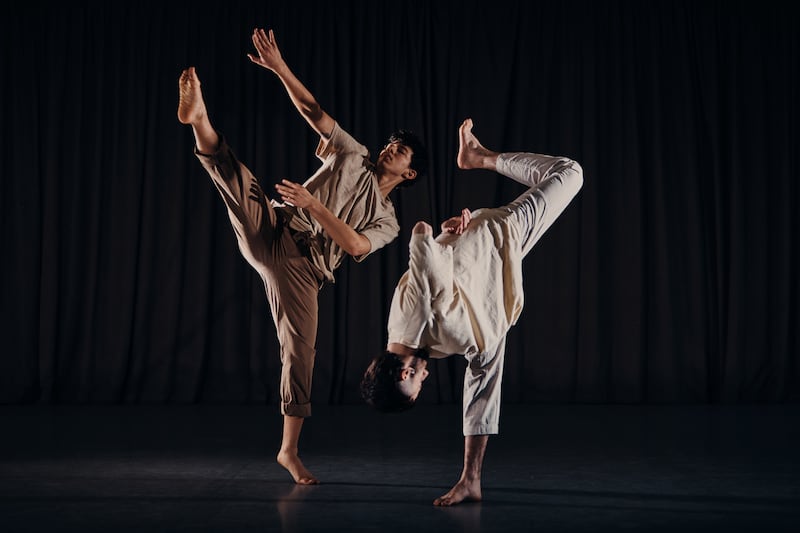Close collaborators in the past, the composer Mel Mercier and the choreographer John Scott have parted ways for their latest project, Begin Anywhere. Not because of any disagreement, but because they are honouring their personal and artistic connections with John Cage and Merce Cunningham.
The late American pair famously worked independently when collaborating: composer Cage and choreographer Cunningham did not discuss their artistic ideas before or during the act of creation. Cunningham’s dancers would often hear the music for the first time on opening night.
In this way Cage’s music and other theatrical elements would not follow the dance, but would coexist on the stage at the same time.
No single art form would be subservient to the other; instead, all would receive equal attention.
RM Block
Cunningham knew that, working with composers such as Cage and Morton Feldman and artists such as Andy Warhol and Robert Rauschenberg, each artist’s contribution would stand on its own terms. Speaking to The Irish Times in 2002, Cunningham quoted Feldman’s justification of this working process: “It’s like your daughter was getting married and was told that her wedding dress wouldn’t arrive until the day of the wedding ... but it’s a Dior!”
Mercier has first-hand experience of seeing this process in action. In 1979 his father, Peadar, who had played bodhrán with The Chieftains, received a phone call from Cage, “who asked my father if he would come into the Radio Centre in RTÉ, where he was recording some traditional musicians for a new piece called Roaratorio: An Irish Circus on Finnegans Wake”, Mercier says. His father asked if Mercier could also come along, and Cage agreed.
“When we arrived we expected to see other musicians, but it was just me, my father, John Cage and his sound engineer, John Fullemann. Cage simply asked us to play. So we sat down and played jig rhythms and reel rhythms on the bodhráns, which they recorded.”

Some months later they got another call. This time they were asked to go to the Pompidou Centre, Paris, with the singer Joe Heaney, the uilleann piper Séamus Ennis and the fiddler Paddy Glackin for the first live performance of the piece. (It had originally been commissioned for German radio.)
It changed the way I understood sound, not just as music but as colour, as texture, as composition
It was the first time the Merciers heard the entire piece of music.
“We had read a little about it, so we knew that Cage had recorded around 3,000 or 4,000 different sounds, all connected to Finnegans Wake. He had travelled around Ireland, collecting sounds with Fullemann, while also gathering recordings from archives worldwide,” Mercier says.
“He also had created his own vocal score, which he recited in an intoned style. Sometimes his voice would come through clearly, and at other times it was drowned out by the layered sounds. At moments the soundscape was chaotic, but then it would quieten down to something as simple as a blackbird’s song.
“For me this turned everything on its head. The biggest revelation was the idea that anything could be music: a motorbike crossing a bridge, a blackbird’s call, Paddy Glackin playing a reel on the fiddle, or John Cage’s voice, sometimes audible, sometimes lost in the layers of sound, but always elusive in meaning. It was all part of the same sonic world.
“That realisation completely opened my ears. It changed the way I understood sound, not just as music but as colour, as texture, as composition. I still carry that with me today.”

This sonic democracy, where every sound had equal importance, also applied to the five musicians who were asked to play in bursts of two to three minutes, but never at the same time.
“Everything I knew about music was rooted in playing together. As a bodhrán player I was used to accompanying others, responding to melodies, fitting into a shared rhythm. But now I had to resist that pull. I had to create an independent, autonomous space within the soundscape and not be drawn into anyone else’s rhythms.
“For the first time the bodhrán had a place of equal importance among all the other instruments. There was a kind of parity of esteem across the entire soundscape that was both liberating and exhilarating.”
Cunningham has had a similar influence on Scott, who first saw the Merce Cunningham Dance Company live in 1997, when they performed a piece called Ocean at the newly opened Waterfront Hall in Belfast.
“Rather than seeing a work by an old choreographer at the end of their career, I saw dance that was vital and exciting,” Scott says. He then travelled to see the company whenever possible, attending rehearsals and meeting Cunningham. “I couldn’t say that I was a friend. He was approachable-slash-unapproachable. But sometimes after a performance you would be told that Merce wanted to see you, and he would say a few words to you.”
Scott developed a working relationship with two members of the company, Ashley Chen and Cheryl Therrien, who had a strong influence on Scott’s own choreography as well as easing the way for his company to perform some of Cunningham’s works, which are usually difficult to license from the Merce Cunningham Trust.
Scott and Mercier have collaborated on original works before, but a few years ago they decided to further explore the worlds of Cage and Cunningham.
The performance will differ each time, shaped by the shared improvisation between the musicians
In 2022 an Arts Council award allowed them to travel to the Irish Arts Center in New York, where Patricia Lent, a director of the trust and, from 1984 to 1993, a member of Cunningham’s company, taught the late choreographer’s methodologies to Scott and five dancers. Meanwhile, Mercier collaborated with some local musicians.
“On the final Friday we held an informal showing,” Scott says. “Initially we thought this project might be a way to explore an evocation of Roaratorio, but by the end we realised something different was emerging.”
What materialised was a new work, Begin Anywhere, commissioned by the Irish Arts Center and based on the Cunningham and Cage collaborations. Lent has also curated and arranged four Cunningham solos into a cohesive event. “They are from RainForest, Travelogue and Changeling, which has an almost surreal quality, and a solo Merce created after visiting the zoo, filled with strange, animalistic movements,” Scott says.

The music for these solos has been written – independently, of course – by the New York composer John King. “He has composed 19 minutes of music, but the dance is about 16 minutes, so we’ll just fade the music down when the dance is over,” Scott says.
For Begin Anywhere, Mercier is working with diverse Irish-based musicians Kevin McNally, Mick O’Shea and Claudia Schwab as well as the Cork sound artist Danny McCarthy, who has created a cassette-tape audio piece.
“All three musicians are great improvisers, and that’s at the heart of the project,” Mercier says. “While we’re not relying on chance procedures like those sometimes used by Cage or Cunningham, or traditional methods like the I Ching, the improvisational nature of the collaboration will naturally lead to a level of chance in the music. The performance will differ each time, shaped by the shared improvisation between the musicians.”
For the premiere in New York, Scott is working with the Irish and New York-based dancers Vinícius Martins Araújo, Morgan Amirah Burns, Boris Charrion, Magdalena Hylak, François Malbranque and Ryan O’Neill. In addition Mercier has interviewed eight former members of the Merce Cunningham Company, whose voices feature in the soundscape.
As Mercier and Scott have been working independently, the only common structure for their music and dance is the duration of the performance. Both believe that this working process is as valid today as when Cage and Cunningham worked together, more than 40 years ago. And both leave a personal artistic legacy.
“What inspires me about Merce is how he kept going,” Scott says. “He had no money in the 1960s, but kept turning up to the studio every day. That was what was important. Keep going on.”
Mercier says: “I think of John Cage and how he lived his life. The courage he had and the resilience he must have needed to be able to challenge the way he did. That requires a kind of passion for life and for discovery. But also courage. And I think that is a source of inspiration just as much today as it was 50 years ago.”
Begin Anywhere and Four Solos is at the Irish Arts Center, New York, from February 12th to 16th; then tours to Black Box, Galway, on February 25th; Dance Limerick, March 8th and 9th; Project Arts Centre, Dublin, from March 11th to 15th; and Civic Theatre, Tallaght, Co Dublin, on March 18th























